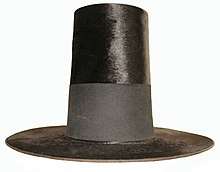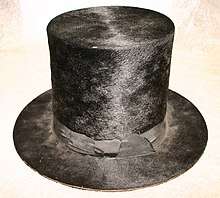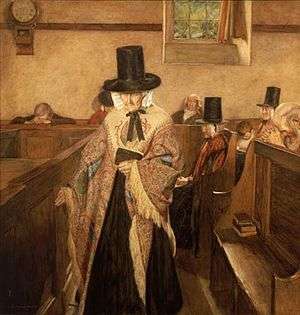Welsh hat
The Welsh hat (Welsh: Het Gymreig) worn by women as part of Welsh national costume is a tall hat, similar to a top hat, or the capotain. It is still worn by Welsh folk-dance women, and schoolgirls, in Wales on St David's Day, but rarely on other occasions.



Two main shapes of Welsh hat were made during the 19th century: those with drum shaped (vertical sided) crowns were worn in north-west Wales, and those with slightly tapering crowns were found in the rest of Wales.
History

The Welsh hat first appeared during the 1830s and over 380 examples are known to have survived. It is said that the Welsh hat was part of a traditional Welsh costume propagated by Lady Llanover [1] but it is unlikely that she had much influence on anyone other than her friends and servants.[2]
The hat may have developed from a number of types of tall hat including the riding hat, which ladies wore during the early part of the 19th century, (as illustrated in the Llanover prints) but no evidence has been discovered which explains why, during the 1830s, the tall hat with the stiff, flat brim, which is unique to the Welsh hat, replaced the other types of men’s hat worn by many rural women in Wales at the time.
By the late 1840s the Welsh hat had become an icon of Wales and was used in cartoons to represent Wales as a nation. It brought forward the image of a happy, hearty, healthy, hard-working Welsh woman. It became part of the national identity and was normally worn with the other elements of Welsh costume, especially the gown or bedgown or Welsh: "gŵn neu betgwn". It continues in use as an icon of Wales in tourist literature.
By the time Sydney Curnow Vosper painted the iconic Salem in 1908, the hat was no longer fashionable, but Vosper still felt the women he painted should wear the now iconic hats. The hat was so rare by the early twentieth century that it is thought Vosper could only find one in the local area, and had to share it amongst the models, painting the same hat into the composition four times.[3]
Battle of Fishguard
The women's tall hats are often cited as a deciding factor in terminating the attempted Last invasion of Britain by Napoleonic forces in 1797. The French soldiers are said to have mistaken the women, seen at a distance returning from work in the fields, carrying pitchforks and wearing red shawls and tall Welsh hats, for a detachment of British "redcoats", whose uniform included tall black hats or shakoes. This is a possible misconception as the Welsh hat, in the form known today at least, didn't exist until the 1830s. There is much evidence to suggest that women in rural Wales had taken to wearing felt hats, like those worn by working men by at least the 1770s.
Dating Welsh hats
It is difficult to date silk Welsh hats; they were being produced in significant numbers during the 1840s and it is possible that they went out of production only a decade or so later. Unlike other fashionable hats, the Welsh hat may have been worn by its owner for many years and then passed down to succeeding generations. The large numbers of surviving hats implies that they were invested with much more than being just an expensive fashion item.
Manufacture
19th century Welsh hats were made in the same way and with the same materials as top hats. Most surviving examples were made by Christys of Stockport and London, and Carver and Co of Bristol who also made top hats. Some were made by Welsh hat makers. The shell was made of buckram (linen fabric), strengthened with shellac or resin and covered with black silk plush (sometimes confusingly known as beaver) but some were made of felt (originally beaver fur, but later fur from other animals). During the 20th century most Welsh hats for adults were made of card covered in black fabric but a few were made of felt especially for Welsh dance teams and women's choirs. Welsh hats for children are made of felt and are normally worn with a cotton or lace cap underneath or may have lace attached to the underside of the brim.
The Cockle Hat
There is an "alternative" women's hat for those who consider the traditional Welsh hat unflattering, in the form of a "cocklewoman's hat", a flat felt hat tied with ribbons on which women balanced the heavy baskets of cockles which they gathered from the coast around Carmarthen Bay when taking them home to cook, and thence to market.
Alternative usage
A derived meaning of Welsh hat is an ancillary stack, usually black in colour and slightly conical, attached to the funnel of a ship to ensure cleaner disposal of exhaust from the engines. This arrangement was used in several passenger liners by the Orient Line in the 1950s.
References
- 'Cambrian costumes dedicated to the nobility and gentry of Wales',(a collection of prints published during the mid-1830s which show many of models wearing riding hats)
- Michael Freeman, ‘Lady Llanover and the Welsh Costume Prints’, The National Library of Wales Journal, xxxiv, no 2 2007, pp.235-251.
- Williams, Tal (1991). Salem Y Llun a'r Llan/Salem Painting and Chapel (8th ed.). Wales: Barddas. ISBN 978-1-906396-13-8.
External links
- Welsh hat is depicted on the mug from Starbucks You Are Here series